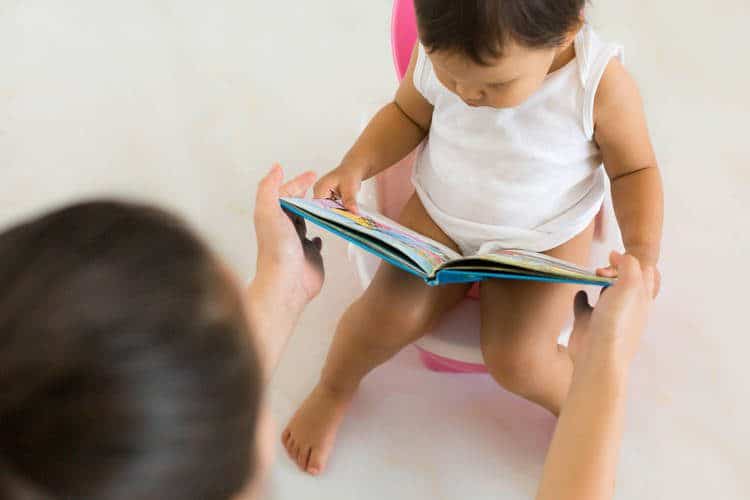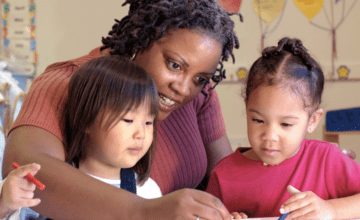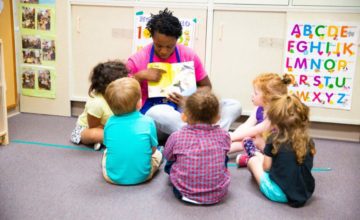There is no one “right” way or one perfect age for learning to use the toilet. Most children learn to use the toilet between the ages of 2 and 4 years old. Toilet learning is a process and both you and your child have your own jobs to do.
It’s the caregiver’s responsibility to:
- Be supportive so the child can learn.
- Recognize that the child is in charge of their body.
- Let the child decide whether to use the potty or a diaper/pull-on diaper (such as Pull-Ups®) each day.
- Teach the child words for body parts, urine, and bowel movements (BM).
- Get the child what they need for toileting (child-sized potty, seat, stool).
- Expect accidents and respond without anger or punishment.
- Remain calm about whether they use the toilet.
It’s the child’s responsibility to:
- Decide whether to use the toilet or a diaper/pull-on diaper.
- Learn their body’s signals for when they need to use the toilet.
- Try using the toilet and decide how long to sit.
Finding what works for each child and family is key. It will take time and many accidents along the way. Being patient will help your child learn. Children with special needs may take longer to learn to use the potty.
Steps to Success
Every child begins learning to use the toilet at their own pace. Start the process when the child is ready.
- Use a child-sized potty or a seat that fits onto the toilet along with a small stool. The stool helps them feel stable and gets them into the best position for having a BM. Let them sit whenever they want, dressed or naked. Don’t force them to sit.
- Ask the child throughout the day if they “need to go potty.” Use whatever language you have chosen. Be willing to accept “no” for an answer.
- Consider letting the child watch you go to the bathroom. They can learn through your modeling.
- Let them be naked. This works best if you have an outdoor space or few rugs. With no clothes on, the child can feel exactly what happens when they go.
- At first, offer the potty to your child every two hours or so. Then offer at specific times during the day: when they first wake up, before lunch, after nap time, and whenever they might typically go. Eventually, the child will recognize their body’s signals and tell you when they need to go.
- If you’re using a potty chair, let the child watch you dump the waste into the toilet. They can flush if they want. Some children like to see the waste disappear and say “bye-bye,” but some don’t.
- Once the child gets the hang of toileting, you can try training underpants. They are thickly padded underwear that offer more protection while letting your child feel the wetness if they start to go. Many families use pull-on diapers (such as Pull-Ups®) but be aware they are very absorbent, feel the same as a regular diaper and the child will not notice when they are wet.
- Nighttime dryness often happens long after the child is using the potty during the day. Many children wear pull-on diapers at night for years. If the child is working on staying dry at night, a plastic sheet can help protect the mattress.
- You might want to use diapers when you’re out of the house until the child can stay dry. Some caregivers even travel with a small potty. If not, know where the bathrooms are in public places. Public bathrooms (especially those with loud and powerful auto-flush toilets) can be scary for young children. Stay close and prepare them for the sounds. The child may also need your help sitting on larger, adult-sized toilets.
Getting Over Power Struggles
Approach toileting without a lot of emotion. The more emotional you are, the more important toileting will seem.
This is the case whether you’re angry and upset about accidents or jumping with joy and clapping when they use the toilet. It’s OK to celebrate, but it helps to use language and praise that focuses on the child’s efforts. Say, “You went potty on your own. You told me you needed to pee. Then you sat and went all by yourself!”
Toddlers are in a phase where they’re becoming more self-sufficient. However, this new independence leads some children to resist the rules. This can cause power struggles. Some children will even try to gain control by holding in their pee or poop. Holding can mean health problems like constipation. If this happens, step back and take the pressure off. Stop talking about the potty for a little while. Wait until the child shows interest again. If you need support, talk with the child’s primary care provider.





